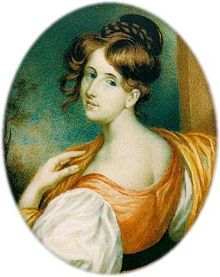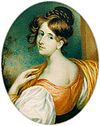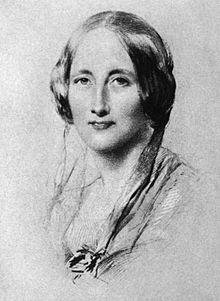- Elizabeth Gaskell
-
Elizabeth Gaskell 
Elizabeth Gaskell: 1832 miniature by William John ThomsonBorn Elizabeth Stevenson
29 September 1810
Chelsea, London, EnglandDied 12 November 1865 (aged 55)
Holybourne, Hampshire, EnglandOccupation Novelist Nationality British Period 1848–65 Spouse(s) William Gaskell Elizabeth Cleghorn Gaskell, née Stevenson (29 September 1810 – 12 November 1865), often referred to simply as Mrs Gaskell, was a British novelist and short story writer during the Victorian era. Her novels offer a detailed portrait of the lives of many strata of society, including the very poor, and as such are of interest to social historians as well as lovers of literature.[1]
Contents
Early life
Gaskell was born Elizabeth Cleghorn Stevenson on 29 September 1810, at 93 Cheyne Walk, Chelsea, which was then on the outskirts of London. Gaskell was the eighth and last of her parents' children; only she and her brother John survived infancy. Her father, William Stevenson, was a Scottish Unitarian minister at Failsworth, Lancashire but resigned his orders on conscientious grounds, moving his family to London in 1806 with intention of going to India after he had been named private secretary to the Earl of Lauderdale, who was to become Governor-General of India. This position did not materialise, and Stevenson was instead nominated Keeper of the Treasury Records. Stevenson's wife, Elizabeth Holland, came from a family from the English Midlands that was well connected with other Unitarian and prominent families like the Wedgwoods, the Turners and the Darwins, and when she died three months after giving birth to Gaskell she left a bewildered husband who saw no other alternative for young Elizabeth but to be sent away to live with her mother's sister Hannah Lumb, in Knutsford, Cheshire.[2]
While she was growing up Gaskell's future was very uncertain as she had no personal wealth and no firm home, even though she was a permanent guest at her aunt and grandparents' house. Her father had married again to Catherine Thomson in 1814 and the couple had a male heir, William (born 1815) and a daughter, Catherine (born 1816). Although Gaskell would sometimes spend several years without seeing her father and his new family, her older brother John would often visit her in Knutsford. John had early been destined for the Royal Navy, like his grandfathers and uncles, but he had no entry and had to go into the Merchant Navy with the East India Company's fleet.[3] John went missing in 1827 during an expedition to India.
Much of Elizabeth's childhood was spent in Cheshire, where she lived with her aunt Hannah Lumb in Knutsford, a town she would later immortalise as Cranford. They lived in a large red brick house, Heathwaite, on Heathside (now Gaskell Avenue), which faces the large open area of Knutsford Heath.
She also spent some time in Newcastle upon Tyne (with Rev. William Turner's family) and in Edinburgh. Her stepmother was a sister of the Scottish miniature artist, William John Thomson, who painted the famous 1832 portrait of Gaskell in Manchester.
Married life and Plymouth Grove
On 30 August 1832 Elizabeth married minister William Gaskell in Knutsford. They spent their honeymoon in North Wales, staying with Elizabeth's uncle, Samuel Holland, who lived near Porthmadog. The Gaskells then settled in Manchester, where William was the minister at Cross Street Unitarian Chapel. Manchester's industrial surroundings would influence Elizabeth's novels in the industrial genre. Their first child, a daughter, was stillborn in 1833. A son, William, (1844–45), died in infancy, and this tragedy became the catalyst for Gaskell's first novel, Mary Barton. Other children were Marianne (1834), Margaret Emily, known as Meta (1837), Florence Elizabeth (1842), and Julia Bradford (1846). Florence married Charles Crompton, a barrister and Liberal politician, in 1862.
In 1850, following the publication of Mary Barton, the family moved to a villa in Plymouth Grove.[4] Elizabeth wrote all her remaining literary works in this home while her husband held welfare committees and tutored the poor in his study. The Gaskells' social circle included literary greats, religious dissenters, and social reformers, including William and Mary Howitt. Charles Dickens and John Ruskin visited Plymouth Grove, as did American writers Harriet Beecher Stowe and Charles Eliot Norton, while conductor Charles Hallé lived close by and taught piano to one of Gaskell's four daughters. Close friend Charlotte Brontë is known to have stayed there three times, and on one occasion hid behind the drawing room curtains as she was too shy to meet Gaskell's visitors.[5]
Gaskell died suddenly of a heart attack in 1865, while visiting a home she had just purchased in Holybourne, Hampshire.
The house on Plymouth Grove remained in the Gaskell family until 1913, after which it stood empty for years and fell into disrepair. The University of Manchester acquired the property in 1969. In 2004 the Manchester Historic Buildings Trust acquired Plymouth Grove and began the process of raising money to restore the home to its original state. Exterior renovations were completed in 2011, and the home is now open for monthly tours while renovations continue. [6][7]
On 25 September 2010 a memorial to Gaskell was dedicated in Poets' Corner in Westminster Abbey. It takes the form of a panel in the Hubbard memorial window, above the tomb of Geoffrey Chaucer. The panel was dedicated by her great-great-granddaughter Rosemary Dabbs and a wreath was laid.[8]
Literary style and themes
Gaskell's first novel, Mary Barton, was published anonymously in 1848. The best known of her remaining novels are Cranford (1853), North and South (1854), and Wives and Daughters (1865). She became popular for her writing, especially her ghost stories, aided by Charles Dickens, who published her work in his magazine Household Words. Her ghost stories are quite distinct, in the "Gothic" vein, from her industrial fiction.
Even though her writing conforms to Victorian conventions (including signing her name "Mrs. Gaskell"), Gaskell usually frames her stories as critiques of contemporary attitudes: her early works focused on factory work in the Midlands. She always emphasised the role of women, with complex narratives and dynamic female characters.[9]
In addition to her fiction, Gaskell also wrote the first biography of Charlotte Brontë, which played a significant role in developing her fellow writer's reputation.
Themes
Unitarianism urges comprehension and tolerance toward all religions and, even though Gaskell tried to keep her own beliefs hidden, she felt strongly about these values, which permeated her works—as in North and South, where "Margaret the Churchwoman, her father the Dissenter, Higgins the Infidel, knelt down together. It did them no harm".[10][11]
Dialect usage
Gaskell's style is notable for putting local dialect words into the voice of middle-class characters and of the narrator. For example, in North and South Margaret Hale suggests redding up (tidying) the Bouchers' house and even offers jokingly to teach her mother words such as knobstick (strike-breaker).[12] Her husband collected Lancashire dialect, and Gaskell defended her use of dialect as expressing otherwise inexpressible concepts in an 1854 letter to Walter Savage Landor:
She used the dialect word "nesh" (soft), which goes back to Old English, in Mary Barton:
Sit you down here: the grass is well nigh dry by this time; and you're neither of you nesh folk about taking cold."[14]and later in 'The Manchester Marriage' [1858]:
Now, I'm not above being nesh for other folks myself. I can stand a good blow, and never change colour; but, set me in the operating-room in the Infirmary, and I turn as sick as a girl.
At Mrs Wilson's death, Norah came back to them, as nurse to the newly-born little Edwin; into which post she was not installed without a pretty strong oration on the part of the proud and happy father; who declared that if he found out that Norah ever tried to screen the boy by a falsehood, or to make him nesh either in body or mind, she should go that very day.[15]
Publications
Novels
- Mary Barton (1848)
- Cranford (1851–3)
- Ruth (1853)
- North and South (1854–5)
- Sylvia's Lovers (1863)
- Wives and Daughters: An Everyday Story (1865)
Novellas and collections
- The Moorland Cottage (1850)
- Mr. Harrison's Confessions, 1851
- The Old Nurse's Story (1852)
- Lizzie Leigh (1855)
- My Lady Ludlow (1859)
- Round the Sofa (1859)
- Lois the Witch (1861)
- A Dark Night's Work (1863)
- Cousin Phillis (1864)
Short stories (partial)
- Libbie Marsh's Three Eras (1847)
- Christmas Storms and Sunshine (1848)
- The Squire's Story (1853)
- Half a Life-time Ago (1855)
- The Poor Clare (1856)
- "The Manchester Marriage" (1858), a chapter of A House to Let, co-written with Charles Dickens, Wilkie Collins, and Adelaide Anne Procter
- The Haunted House (1859), co-written with Charles Dickens, Wilkie Collins, Adelaide Proctor, George Sala and Hesba Stretton.
- The Half-brothers (1859)
- The Grey Woman (1861)
Non-fiction
- An Accursed Race (1855)
- The Life of Charlotte Brontë (1857)
See also
Notes
- ^ "Children in Early Victorian England: Infant Feeding in Literature and Society 1837–1857." Tropical Pediatrics and Environmental Child Health August 1978
- ^ Pollard, Arthur (1965). Mrs. Gaskell: Novelist and Biographer. Manchester University Press. p. 12. ISBN 0-674-57750-7.
- ^ Gérin, Winifred (1976). Elizabeth Gaskell. Oxford University Press. pp. 10–17. ISBN 0-19-281296-3.
- ^ Uglow J. Elizabeth Gaskell: A Habit of Stories (Faber and Faber; 1993) (ISBN 0-571-20359-0)
- ^ Nurden, Robert (26 March 2006), An ending Dickens would have liked, "Independent", The Independent (London), http://arts.independent.co.uk/books/features/article353793.ece.
- ^ http://www.elizabethgaskellhouse.org/
- ^ "Elizabeth Gaskell's house damaged after lead theft". BBC News. 11 May 2011. http://www.bbc.co.uk/news/uk-england-manchester-13357245.
- ^ "Elizabeth Gaskell" at westminster-abbey.org
- ^ Excluding Reference to Gaskell's Ghost Stories, Abrams, M.H., et al. (Eds.) "Elizabeth Gaskell, 1810–1865". The Norton Anthology of English Literature, The Major Authors: The Romantic Period through the Twentieth Century, 7th ed., Vol. B. New York, London: W.W. Norton & Company, 2001. ISBN 0-393-97304-2. DDC 820.8—dc21. LC PR1109.N6.
- ^ Gaskell, Elizabeth (1854-5). North and South. Penguin Popular Classics. p. 277. ISBN 978-0-14-062019-1.
- ^ Easson, Angus (1979). Elizabeth Gaskell. Routledge & Kegan Paul Ltd. pp. 12–17. ISBN 0-7100-0099-5.
- ^ a b Ingham P. (1995) Introduction to the Penguin Classics edition of North and South
- ^ Chapple JAV, Pollard A, eds. The Letters of Mrs Gaskell. Mandolin (Manchester University Press), 1997
- ^ Gaskell, E (1848), "1", Mary Barton.
- ^ Stories of Successful Marriages, Victorian Short Stories, The Project Gutenberg, http://www.gutenberg.org/files/15252/15252.txt.
External links
General and miscellaneous
- "The Gaskell Society". http://www.gaskellsociety.co.uk.
- "The Gaskell Web". Nagoya University. http://www.lang.nagoya-u.ac.jp/~matsuoka/Gaskell.html.
- "Elizabeth Gaskell". Victorian Web. http://www.victorianweb.org/authors/gaskell/gaskellov.html.
- Works by Elizabeth Gaskell at Project Gutenberg
- Archival material relating to Elizabeth Gaskell listed at the UK National Register of Archives
- "North and South (free unabridged audiobook download)". LibriVox. http://librivox.org/north-and-south-by-elizabeth-gaskell/.
- North and South, the Musical – a new musical based on E. Gaskell's novel
- The Visual Life of Elizabeth Gaskell
- "Elizabeth Gaskell Bibliographer". Nancy S. Weyant. http://www.nancyweyant.com/index.php/pages/GaskellBibliography-Intro.html.
Locations
- "Elizabeth Gaskell House, 84 Plymouth Grove". http://www.elizabethgaskellhouse.org.
- "Brook Street Chapel: the Gaskell burial place". http://www.brookstreetchapel.org.
- "A history of 84 Plymouth Grove and pictures from now and then". Nagoya University. http://www.lang.nagoya-u.ac.jp/~matsuoka/EG-Plymouth.html.
- "Memorial Page for Elizabeth Gaskell". Find a Grave database. http://www.findagrave.com/cgi-bin/fg.cgi?page=gr&GRid=2305.
Works by Elizabeth Gaskell Novels: Mary Barton (1848) • Cranford (1851–53) • Ruth (1853) • North and South (1854–55) • My Lady Ludlow (1859 novella) • Sylvia's Lovers (1863) • Wives and Daughters (1865)
Short story collections: The Moorland Cottage (1850) • The Old Nurse's Story (1852) •
Lizzie Leigh (1855) • Round the Sofa (1859) • Lois the Witch (1861) • A Dark Night's Work (1863)Short stories (partial): "Christmas Storms and Sunshine" (1848) • "Mr. Harrison's Confessions" (1851) • "The Squire's Story" (1853) • "Half a Life-time Ago" (1855) • "An Accursed Race" (1855) • "The Manchester Marriage" (1858) • "The Half-brothers" (1859) • "The Grey Woman" (1861) • "Cousin Phillis" (1864)Non-fiction: Categories:- 1810 births
- 1865 deaths
- English biographers
- English novelists
- English short story writers
- English Unitarians
- People from Chelsea, London
- Victorian novelists
- Victorian women writers
- Women novelists
- Women of the Victorian era
- 19th-century women writers
Wikimedia Foundation. 2010.


